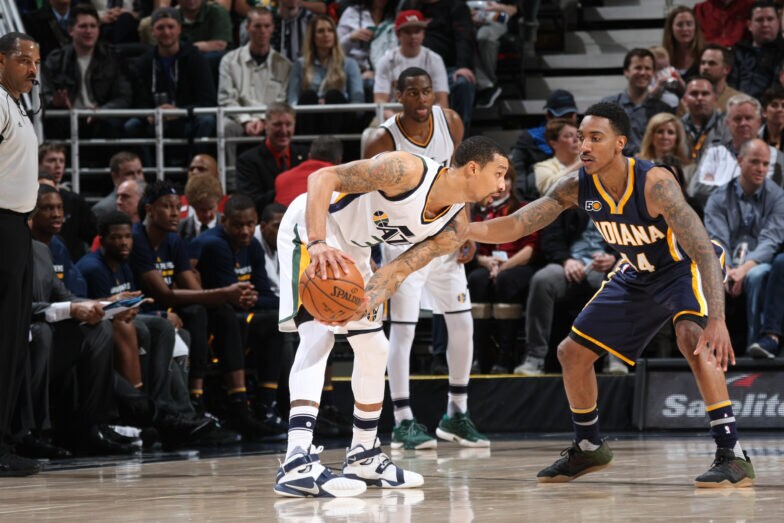
If we were to wait around for George Hill or Jeff Teague to tell us which of their current teams got the better of the trade last offseason in which the two point guards moved, respectively, to the Utah Jazz and the Indiana Pacers, we would be waiting a looonnnggg time.
They’re not exactly Draymond Green and LeBron James when it comes to never meeting a hot microphone they didn’t like.
Even if we demanded that each give us an answer outright, we probably would have to lean in and cup our ears just to hear it. For whatever level of communicating those two guys do on the court as their squad’s so-called floor generals, they’re way more John Stockton than Magic Johnson when it comes to sharing thoughts, opinions and yuks with media folks who cover the league.
Still, with Utah in Indianapolis Monday night for its second and final game of 2016-17 against the Pacers (7 ET, NBA LEAGUE PASS), it’s the proper time to assess the impact the deal had on both clubs. (Actually, it was a three-team trade in which forward Taurean Prince — who was originally picked by the Jazz in the 2016 Draft — was moved to the Hawks.)
A more proper time to assess the Hill-Teague maneuver might be after the game at Bankers Life Fieldhouse, because the first meeting was a decisive victory for Hill. He scored 30 points on Jan. 21 in Salt Lake City to lead the Jazz past Indiana 109-100 (Teague finished with 19 points in defeat).
Overall in 2016-17, Hill is averaging 17.2 points, 3.4 rebounds and 4.1 assists, making 40.5 percent of his 3-pointers and shooting 47.7 percent overall. Teague’s corresponding stats are 15.0, 4.4 and 7.9, along with 34.9 percent from the arc and 43.8.
How have their teams done, before and after? Utah is 43-27 this season, on pace to win 50 games for the first time since 2009-10 and vying for homecourt advantage to start the playoffs. Last season, the Jazz were 40-42 and missed the postseason for the fourth straight season.
The Pacers have gone the other way in the standings. After their 45-37 finish and seven-game tussle with Toronto in the first round, they are 35-34 this season and unlikely to match their 2015-16 record. The Pacers are good enough to hold up the No. 6 spot in the East. But with Milwaukee, Miami, Detroit and Chicago all within two victories, a return to the postseason hardly is assured.
In sheer net ratings (per NBA.com/Stats), Utah has improved from 12th (plus-1.6) last season to 4th now (plus-4.8). Indiana was 11th last season (plus-2.2) but has dropped to 17th since Teague’s arrival (minus-0.8).
How much is attributable specifically to the point guards in their new jobs? That’s always trickier to evaluate. But here are the on/off numbers for the two with their teams:
Hill: 110.0/99.7 on the court, 104.8/103.6 off the court.
Teague: 106.5/106.0 on the court, 102.1/105.3 off the court.
So as dependent as those ratings are on teammates, the opponents and the matchups when individuals play or sit, it seems clear that Hill has had a bigger impact on Utah’s performance this season than Teague has had on Indiana’s.
To take that a step further, courtesy of our own stats guru John Schuhmann and our site’s “Impact” tool, drilling down to see how the Jazz do when its two other most pivotal players are involved boosts Hill’s case. When he’s out there with All-Star Gordon Hayward and center Rudy Gobert, Utah has outscored opponents by 13.2 points per 100 possessions. When those two don’t have Hill with them, they’re only plus-6.3.
One category in which Teague has a clear advantage over Hill this season has been in simply showing up. He has started all 68 games for an Indiana team that has used eight different starting lineups. And after an early learning curve in the first week or two, since Nov. 3 Teague has averaged 15.5 points, 4.0 rebounds and 8.1 assists. He also ranks seventh in the NBA in assists and the Pacers – whose most notable personnel changes last summer swapped defense (Hill and Ian Mahinmi) for offense (Teague, Al Jefferson and Aaron Brooks) – haven’t had too big of a change in how they play (98.47 pace, compared to 98.99 last season).
Hill has missed 27 games for Utah, for reasons ranging from sprains to his right thumb (eight games) and left big toe (13) to a cut lip with concussion-like symptoms and toe soreness or general rest. The Jazz are 29-14 when Hill plays vs. 14-13 when Dante Exum (11-7) or Shelvin Mack (3-6) start at his position.
Oh and to keep things parallel here, we should note that Utah is, er, playing faster too. But the Jazz have gone from 93.26, slowest in the NBA last season, to 93.7, slowest in the league this season.
Both guards are earning about the same this season (Hill $8 million, Teague $8.8 million). Both will hit free agency this summer, with noise that San Antonio might be interested in bringing back Hill while the New York Knicks might be a potential destination for Teague.
Both the Jazz’s and the Pacers’ players and coaches will tell you they like their current point guards just fine and, as noted above, neither of these guys is going to hit any campaign trail for himself.
So the bottom line: Hill’s impact on Utah – as a two-play player and as a veteran to buy time for Exum’s development – was expected back in July to be a little greater on the Jazz’s ambitions. And, even allowing for something dramatic in Indianapolis Monday night, that’s how it has played out.
Steve Aschburner has written about the NBA since 1980. You can e-mail him here, find his archive here and follow him on Twitter.
The views on this page do not necessarily reflect the views of the NBA, its clubs or Turner Broadcasting.









